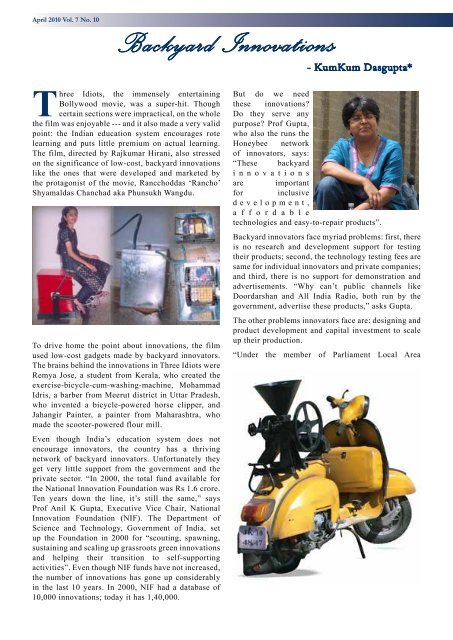'The whole world is but one family' - Bharatiya Vidya Bhavan Australia
'The whole world is but one family' - Bharatiya Vidya Bhavan Australia
'The whole world is but one family' - Bharatiya Vidya Bhavan Australia
Create successful ePaper yourself
Turn your PDF publications into a flip-book with our unique Google optimized e-Paper software.
April 2010 Vol. 7 No. 10<br />
Backyard Innovations<br />
Three Idiots, the immensely entertaining<br />
Bollywood movie, was a super-hit. Though<br />
certain sections were impractical, on the <strong>whole</strong><br />
the film was enjoyable --- and it also made a very valid<br />
point: the Indian education system encourages rote<br />
learning and puts little premium on actual learning.<br />
The film, directed by Rajkumar Hirani, also stressed<br />
on the significance of low-cost, backyard innovations<br />
like the <strong>one</strong>s that were developed and marketed by<br />
the protagon<strong>is</strong>t of the movie, Rancchoddas ‘Rancho’<br />
Shyamaldas Chanchad aka Phunsukh Wangdu.<br />
To drive home the point about innovations, the film<br />
used low-cost gadgets made by backyard innovators.<br />
The brains behind the innovations in Three Idiots were<br />
Remya Jose, a student from Kerala, who created the<br />
exerc<strong>is</strong>e-bicycle-cum-washing-machine, Mohammad<br />
Idr<strong>is</strong>, a barber from Meerut d<strong>is</strong>trict in Uttar Pradesh,<br />
who invented a bicycle-powered horse clipper, and<br />
Jahangir Painter, a painter from Maharashtra, who<br />
made the scooter-powered flour mill.<br />
Even though India’s education system does not<br />
encourage innovators, the country has a thriving<br />
network of backyard innovators. Unfortunately they<br />
get very little support from the government and the<br />
private sector. “In 2000, the total fund available for<br />
the National Innovation Foundation was Rs 1.6 crore.<br />
Ten years down the line, it’s still the same,” says<br />
Prof Anil K Gupta, Executive Vice Chair, National<br />
Innovation Foundation (NIF). The Department of<br />
Science and Technology, Government of India, set<br />
up the Foundation in 2000 for “scouting, spawning,<br />
sustaining and scaling up grassroots green innovations<br />
and helping their transition to self-supporting<br />
activities”. Even though NIF funds have not increased,<br />
the number of innovations has g<strong>one</strong> up considerably<br />
in the last 10 years. In 2000, NIF had a database of<br />
10,000 innovations; today it has 1,40,000.<br />
- KumKum Dasgupta*<br />
But do we need<br />
these innovations?<br />
Do they serve any<br />
purpose? Prof Gupta,<br />
who also the runs the<br />
H<strong>one</strong>ybee network<br />
of innovators, says:<br />
“These backyard<br />
i n n o v a t i o n s<br />
are important<br />
for inclusive<br />
d e v e l o p m e n t ,<br />
a f f o r d a b l e<br />
technologies and easy-to-repair products”.<br />
Backyard innovators face myriad problems: first, there<br />
<strong>is</strong> no research and development support for testing<br />
their products; second, the technology testing fees are<br />
same for individual innovators and private companies;<br />
and third, there <strong>is</strong> no support for demonstration and<br />
advert<strong>is</strong>ements. “Why can’t public channels like<br />
Doordarshan and All India Radio, both run by the<br />
government, advert<strong>is</strong>e these products,” asks Gupta.<br />
The other problems innovators face are: designing and<br />
product development and capital investment to scale<br />
up their production.<br />
“Under the member of Parliament Local Area









